You can’t control what your customers think, but you can subtly influence how they feel about what you’re showing them. Color psychology isn’t a new field of marketing study. Restaurants, movie poster designers, and artists for centuries have utilized colors to push customers and viewers one way or another. When designing mailers and pieces of advertising, knowing which colors are saying what to your audience is key.
The Subtle Play
Using color isn’t going to send the same message as the text you have on display. Your text and color should work together to send your audience in one direction. You can’t just send your customers a red postcard hoping they’ll understand what you’re trying to say. Instead, use the color to gently nudge them down the path your text and other images have laid out.
Red
When you see red, a few things happen. Your heart rate can increase, blood pressure as well. Because we are conditioned to instinctively notice red first in most contexts. It triggers the danger response, if even on a low-key level. Stop signs, danger labels, and poisonous berries aren’t the only context we see red though. It’s also the color of passion, love, and desire. Context is important, so keep it in mind when dealing with such a charged color.
Yellow
In smaller doses, yellow is an attention grabber. It stands out in a light way without overpowering everything around it. When used in this way, it evokes excitement, joy, and happiness. Too much can have the opposite effect actually. It’s known that too much yellow can increase anxiety, agitation, and can even make babies cry. A little bit goes a long way with yellow.
Blue
Blue is typically associated with boys. Toys, clothes, accessories, etc. for children use blue as a signifier of “boy-ness” for quick identification. Beyond the gender association, blue is also viewed as a ‘cooler’ color. It doesn’t jump out and command attention, especially when compared with colors like red and yellow. This relaxed feeling means that it’s often used to signify sophistication and stability. Alternatively, the darker tones can be used to imply sadness and depression.
Black
Black is a color that people can recognize without any question. Just like with other colors, context is important. It can be an imposing void, an elegant finish, or an entrancing mystery. Large black text implies confidence and boldness. Those advertisements that are delivering a straightforward message use black to show a no-nonsense attitude. When attached to a sad and somber situation, black can also be a signifier of grief.
Context
As mentioned above, context is important for how you use colors. If you just throw colors onto a mailer or ad without considering the implied psychology, you can be sending a very different message than what you intended. Just like you wouldn’t send out a text copy without reading it and considering it from different angles, make sure your colors pass the same test. A critical eye is crucial to a successful color arrangement on any kind of ad copy you want to send out to your audience.





